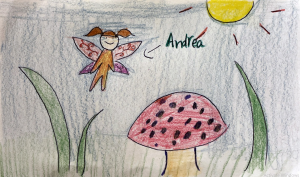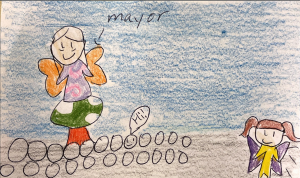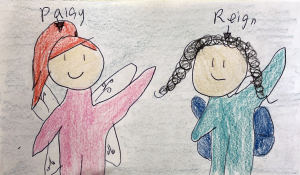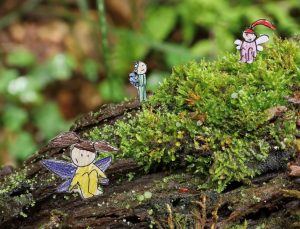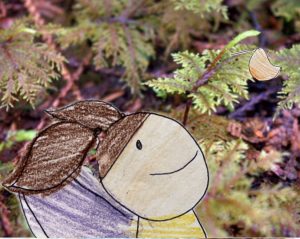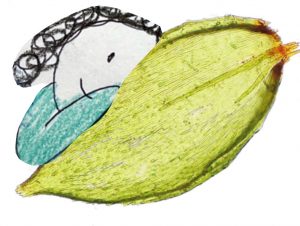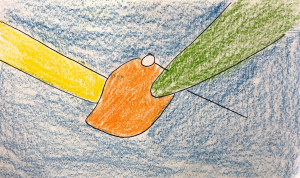A Children’s Novella: The Great Moss Race
Written by: Alison Wu
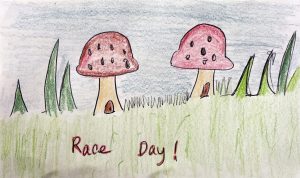 The day has come to announce the teams for the 50th annual Great Moss Race at Pixie Village. Every year, the pixies of Pixie Village gather to celebrate nature and compete in teams for the Pixie Village Grand Cup.
The day has come to announce the teams for the 50th annual Great Moss Race at Pixie Village. Every year, the pixies of Pixie Village gather to celebrate nature and compete in teams for the Pixie Village Grand Cup.
One early morning, Andrea flew to Pixie Field. She was going to meet her team for the race!
“Welcome everybody!” the mayor said. “Today you will meet your teams for the 50th annual Great Moss Race. The competition is next week, so it’ll be important to get to know each other.”
“As a reminder, this is how the race will work: there will be 4 obstacles. At each obstacle, there will be a flag that will need to be retrieved. The first team to finish the race with all 4 flags wins the Great Moss Cup.”
“Now, here is the list of racers on each team.”
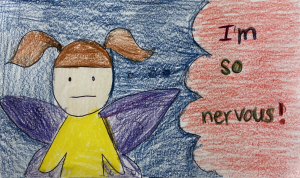 Andrea got nervous. There were so many teams, and racers. How was she going to win?
Andrea got nervous. There were so many teams, and racers. How was she going to win?
Andrea almost didn’t hear the mayor announce, “and the last team that will be participating in the race is Andrea, Daisy and Reign.”
Through the crowd, Andrea looked spotted Daisy and Reign. She knew them from school. While Andrea was a sun pixie, Daisy and Reign were different.
Reign was a river pixie.
Andrea knew that they had to work together as a team to win the Cup. But she was worried. They were all so different, how would they be able to work together?
 The next week, Andrea, Daisy and Reign trained. They stretched. They ran.
The next week, Andrea, Daisy and Reign trained. They stretched. They ran.
Andrea, Daisy and Reign also studied. They read books. They explored the fields. They did not know what mosses they would encounter in the race.
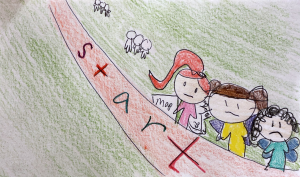 Soon, it was the day of the competition. Andrea, Daisy and Reign lined up at the starting line. Maps were handed out to give directions to each obstacle.
Soon, it was the day of the competition. Andrea, Daisy and Reign lined up at the starting line. Maps were handed out to give directions to each obstacle.
“Let the 50th annual Great Moss Race begin!” The mayor shouted.
The teams took off.
Andrea, Daisy and Reign raced towards the first course.
“Our first flag should be around here in the Tetraphis pellucida,” Daisy exclaimed.
“Wow! There are so many gemmiferous shoots here,” said Reign.
Andrea nodded. Reign was right. On the wood surface, there were a lot of gemmiferous shoots, but there was no flag.
Andrea flew along the wood, spotting some gemmiferous shoots and sporophytes. If she was the mayor, where would she put the flag?
“Found it,” Reign shouted, “it’s in one of the splash cups.”
Reign tucked the flag into her pocket while Daisy shouted: “ To the next course!”
Andrea, Daisy and Reign flew onwards until they reached their second obstacle.
“Hylocomium splendens,” Reign whispered while the team looked around the forest floor.
As Andrea walked through the forest of Hylocomium splendens, she spotted the flag near one of the red-brown stems.
Andrea jumped on the steps of the moss and grabbed it.
With two flags in their pockets, the team was ready for their third obstacle.
Andrea, Daisy and Reign flew onwards until they saw a granite cliff edge.
“Andreaea nivalis,” Andrea exclaimed. “The moss I was named after.”
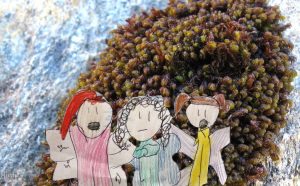 The team of pixies flew up. Then, they flew down. Then, they flew up again. The rock face was tall, and they could see the entire patch of Andreaea nivalis in perfect view. But where was the flag?
The team of pixies flew up. Then, they flew down. Then, they flew up again. The rock face was tall, and they could see the entire patch of Andreaea nivalis in perfect view. But where was the flag?
From the corner of her eye, Andrea spotted a weird-looking sporophyte. Suddenly, she knew the flag was concealed in the sporangium.
“How are we going to get the flag?” Andrea asked her teammates. “It’s in the sporangium. Our arms can’t fit through the lines of dehiscence, and we’re not strong enough to pry them open.”
Daisy climbed up the sporophyte and shook it. But nothing happened.
Reign tried to water the moss with her pixie powers. “Maybe it’s not opening because it’s thirsty. The tufts are brittle.” But nothing happened.
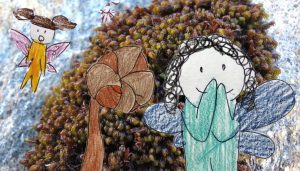 Then, a lightbulb went off in Daisy’s head. “The lines of dehiscence only open to release spores during optimum conditions. Andreaea nivalis’ optimum conditions are when it’s dry. Andrea! We need sun rays.”
Then, a lightbulb went off in Daisy’s head. “The lines of dehiscence only open to release spores during optimum conditions. Andreaea nivalis’ optimum conditions are when it’s dry. Andrea! We need sun rays.”
Andrea made sun rays, and the lines of dehiscence opened. She grabbed the flag.
“Hurry,” Reign said, “we’re falling behind.” Andrea, Daisy and Reign quickly flew up the cliff ledge.
 Once reaching the top of the cliff, they saw stations. Already, two teams made it to the final obstacle course.
Once reaching the top of the cliff, they saw stations. Already, two teams made it to the final obstacle course.
“A matching game! We have to match the leaf to the moss species we just saw in the obstacle course,” said Daisy.
Andrea wasn’t nervous. They practised keying mosses during their training. There also was a dichotomous key on the table which helped.
“One of these leaves is double-costate. It’s Hylocomium splendens,” Reign said and matched the photo to its name.
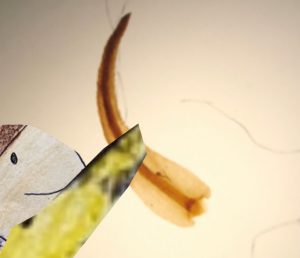
“The next two leaves both have a single costa,” Daisy murmured.
Andrea and Reign flipped through the dichotomous key.
“Because this leaf is brown and more elongate, this is Andreaea nivalis,” Andrea said.
“That would make this one: Tetraphis pellucida,” Daisy and Reign said in unison.
Now, all the leaves were matched. Their station supervisor looked at their pairings and handed them their final flag. With 4 flags in hand, Andrea, Daisy and Reign reached the finish line first.
 “It’s with great honour that I announce the winners of the 50th annual Great Moss Race: Andrea, Daisy and Reign,” said the mayor.
“It’s with great honour that I announce the winners of the 50th annual Great Moss Race: Andrea, Daisy and Reign,” said the mayor.
Andrea beamed. She had won the race, and she couldn’t have done it without her new best friends.
–
THE END
–
For students and parents interested in learning more about the contents of the novella:
–
Mosses to Know:
–
Andreaea nivalis: forms dark red brown shoots and can be found on rock faces.
Hylocomium splendens: forms arching shoots and can be found on forest floors, tree trunks and decaying logs.
Tetraphis pellucida: forms short green unbranched shoots and can be found on decaying wood.
–
Key words (are bolded in text):
–
Dichotomous key: is a tool used to identify different organisms, including mosses. It consists of a series of statements with two choices at each step which leads to the correct identification of an organism.
Double-costate: characterized by the presence of two mibribs on a leaf.
Gemmiferous shoots: produce gemmae which are structures functioning in vegetative reproduction.
Lines of Dehiscence: is the splitting of the sporangium along its built-in lines of weakness to release spores.
Single costa: characterized by the presence of one mibrib on a leaf.
Splash cup: serves to either disperse sperm or gemmae. It consists of a whorl of leaves.
Sporangium: where spores are formed.
Spores: a haploid cell produced by meiosis. Its germination gives rise to protonema.
Sporophytes: are the diploid generation of mosses. It is attached to the gametophyte and produces spores.
–
References:
–
Biology 321 – UBC. (2023). Retrieved April 11, 2023, from Botany.ubc.ca website: https://www3.botany.ubc.ca/bryophyte/mossintro.html
Department of Climate Change, Energy, the Environment and Water. (2022). Flora of Australia Glossary — Mosses – DCCEEW. Retrieved April 12, 2023, from Dcceew.gov.au website: https://www.dcceew.gov.au/science-research/abrs/online-resources/glossaries/mosses
Ellis, S. (2021). Andreaea nivalis Hook. | Introduction to Bryophytes. Retrieved April 12, 2023, from Blogs.ubc.ca website: https://blogs.ubc.ca/biology321/?page_id=2403
Ellis, S. (2021). Hylocomium splendens (Hedw.) Schimp. | Introduction to Bryophytes. Retrieved April 11, 2023, from Blogs.ubc.ca website: https://blogs.ubc.ca/biology321/?page_id=520
Ellis, S. (2021). Tetraphis pellucida Hedw. | Introduction to Bryophytes. Retrieved April 12, 2023, from Blogs.ubc.ca website: https://blogs.ubc.ca/biology321/?page_id=1843
Lepp, H. (2023). Splash cups – Reproduction & dispersal – bryophyte. Retrieved April 11, 2023, from Anbg.gov.au website: https://www.anbg.gov.au/bryophyte/splash-cups.html#:~:text=Splash%20cups%20serve%20two%20roles,a%20good%20example%20of%20this.
Maier, K. (1973). Dehiscence of the Moss Capsule: II. The Anulus: Analysis of Its Functional Apparatus on JSTOR. Retrieved April 11, 2023, from Jstor.org website: https://www.jstor.org/stable/43339344
National Park Service. (2014). Using Dichotomous Keys – Teachers (U.S. National Park Service). Retrieved April 12, 2023, from Nps.gov website: https://www.nps.gov/teachers/classrooms/dichotomous-key.htm#:~:text=A%20dichotomous%20key%20is%20an,users%20to%20the%20correct%20identification.
Yang, N.-Y., Jia, X.-L., Sui, C.-X., Shen, S.-Y., Dai, X.-L., Xue, J.-S., & Yang, Z.-N. (2022). Documenting the Sporangium Development of the Polypodiales Fern Pteris multifida. Frontiers in Plant Science, 13. https://doi.org/10.3389/fpls.2022.878693
–
Image Credits (links):
–
https://www.centralcoastbiodiversity.org/step-moss-bull-hylocomium-splendens.html
https://wnmu.edu/academic/nspages/gilaflora/hylocomium_splendens.html
http://www.milueth.de/Moose/habitat/Andreaea%20nivalis%20002d.html

